Commander-in-Chief, Western Approaches
Coordinates: 53°24′27″N 2°59′36″W / 53.4074°N 2.9932°W
| Commander-in-Chief, Western Approaches | |
|---|---|
|
Commander Cross, Staff Officer Convoys, (left) discussing a special convoy movement map with Captain Lake, RN, Duty Officer in the Operations Room at Derby House, Liverpool. | |
| Active | 1939-1945 |
| Country |
|
| Branch |
|
| Type | Fleet |
| Commanders | |
| Notable commanders | Percy Noble, Max Horton |
Commander-in-Chief, Western Approaches was the commander of a major operational command of the Royal Navy during World War II. The admiral commanding, and his forces, sometimes informally known as 'Western Approaches Command,' were responsible for the safety of British shipping in the Western Approaches.
History
Admiral Martin Dunbar-Nasmith, who had been Commander-in-Chief, Plymouth, also took over responsibility for the Western Approaches from the start of World War II.[1]
After the fall of France in June 1940, the main North Atlantic convoy routes were diverted around the north of Ireland through the north-western approaches.[2] By late 1940, the location of the Combined Operations headquarters at Plymouth was increasingly awkward and the decision was taken to move the Combined Operations headquarters to Liverpool.[2] On 7 February 1941, the headquarters was established at Derby House, Liverpool,[2] with a secondary control bunker built in Magee College, Derry.[3] The headquarters of No. 15 Group RAF (part of Coastal Command) moved to Liverpool at the same time.[4] On 17 February 1941 Admiral Sir Percy Noble was appointed as the new Commander-in-Chief, Western Approaches Command.[2]
Over the next two years, Admiral Noble built up the bases for the North Atlantic escort groups at Greenock on the Clyde, Derry and Liverpool and set up the training facilities that were the foundations for eventual victory in the Battle of the Atlantic.[5]
On 19 November 1942, Admiral Max Horton replaced Admiral Noble; Horton then was Commander-in-Chief until Western Approaches Command closed on 15 August 1945.[2]
Horton’s leadership played a vital role in the final defeat of the U-boat menace. Horton used the increasing number of escorts that were available to the command to organize "support groups" that were used to reinforce convoys that came under attack.[6] Unlike the regular escort groups, the support groups were not directly responsible for the safety of any particular convoy. This freedom gave them much greater tactical flexibility, allowing the support groups to detach ships to hunt submarines spotted by reconnaissance or picked up by high-frequency direction finding (HF/DF). In situations where the regular escorts would have had to return to their convoy, the support groups were able to persist in hunting a submarine for many hours until it was forced to the surface.
Museum
The reinforced central core of the command bunker at Derby House proved too costly to demolish, and so whilst the rest of the building has been converted to modern offices, the bunker has been restored as a museum, open to the public. The museum is known as the Western Approaches - Liverpool War Museum.[2]
Commanders-in-Chief, Western Approaches

Commanders-in-Chief included:[7]
| Rank | Name | Term began | Term ended | |
|---|---|---|---|---|
| Commander-in-Chief, Western Approaches | ||||
| Admiral | Martin Dunbar-Nasmith | 9 September 1939 | 17 February 1941 | |
| Admiral | Sir Percy Noble | 17 February 1941 | 19 November 1942 | |
| Admiral | Max Horton | 19 November 1942 | 15 August 1945 | |
See also
References
- ↑ Liddell Hart Centre for Military Archives
- 1 2 3 4 5 6 History of Derby House (Western Approaches Museum), accessed June 2008
- ↑ "Magee College's secret Battle of the Atlantic bunker". BBC. 3 June 2013. Retrieved 14 December 2014.
- ↑ The Role of Western Approaches
- ↑ Ireland, Bernard (2003). Battle of the Atlantic. Barnsley: Pen and Sword. p. 96. ISBN 1-8441-5001-1.
- ↑ Headquarters Western Approaches
- ↑ Whitaker's Almanacks 1939 - 1945
External links
- Western Approaches - Liverpool War Museum - official site
